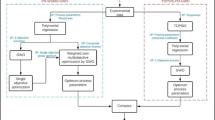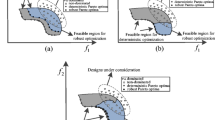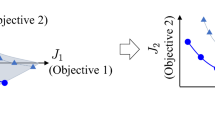Abstract
In this paper, a multi-objective uniform-diversity genetic programming (MUGP) algorithm deployed for robust Pareto modeling and prediction of complex nonlinear processes using some input-output data table. The uncertainties included in measured data are considered to obtain more robust models. The considered benchmarks are an explosive cutting and forming processes, in which the nonlinear behavior between the input and output of processes are detected using MUGP. For both case studies, a multi-objective modeling and prediction procedure firstly performed using deterministic data. Secondly, the same identification procedure carried out using probabilistic uncertainty in the experimental input-output data. The objective functions considered are namely, training error, prediction error and number of tree nodes (complexity of models) in the deterministic approach. Accordingly, the mean and standard deviation of training error and prediction error are considered in robust Pareto modeling and prediction of such processes. In this way, Pareto front of such modeling and prediction is first obtained for both explosive cutting and forming processes with deterministic data. Such Pareto front is then obtained using experimental input-output-data having probabilistic uncertainty in input parameters through a Monte Carlo simulation (MCS) approach. In addition, it has been shown that for both cases, the trade-off models obtained from deterministic data have significant biases when tested on data with probabilistic uncertainty. Finally, the obtained results of such multi-objective robust model identification show promising results in terms of compensating uncertainty in the experimental input-output-data.















Similar content being viewed by others
References
Baker, E. L. (1993). Modeling and optimization of shaped charge liner collapse and jet formation, technical report araed-tr-92019. New Jersey: US army armament research, development and engineering center, Picatinny Arsenal.
Bi, S., Deng, Z., & Chen, Z. (2013). Stochastic validation of structural FE-models based on hierarchical cluster analysis and advanced Monte Carlo simulation. Finite Elements in Analysis and Design, 67, 22–33.
Bieda, B. (2011). Stochastic Assessment by Monte Carlo simulation for LCI applied to steel process chain: The ArcelorMittal Steel Poland SA in Krakow, Poland case study. Innovations in Sharing Environmental Observations and Information (pp. 787–798).
Biwer, A., Griffith, S., & Cooney, C. (2005). Uncertainty analysis of penicillin V production using Monte Carlo simulation. Biotechnology and Bioengineering, 90(2), 167–179.
Chan, K. Y., Kwong, C. K., Dillon, T. S., & Tsim, Y. C. (2013). Reducing overfitting in manufacturing process modeling using a backward elimination based genetic programming. Journal of Applied Soft Computing, 11, 1648–1656.
Daehn, G. S. (2006). High-velocity metal forming. In S. L. Semiatin (Ed.), ASM handbook, Volume 14B: Metalworking: Sheet forming (pp. 405–418). doi:10.1361/asmhba0005127.
Daehn, G. S., Altynova, M., Balanethiram, V. S., Fenton, G., Padmanabhan, M., Tamhane, A., et al. (1995). High-velocity metal forming: An old technology addresses new problems. In Sheet metal forming symposium at the TMS/ASM Materials. Week in Cleveland, Ohio.
Garg, A., Tai, K., & Savalani, M. M. (2014a). Formulation of bead width model of an SLM prototype using modified multi-gene genetic programming approach. International Journal of Advanced Manufacturing Technology, 73, 375–388.
Garg, A., Tai, K., Lee, C. H., & Savalani, M. M. (2013a). A hybrid M5’-genetic programming approach for ensuring greater trustworthiness of prediction ability in modelling of FDM process. Journal of Intelligent Manufacturing. doi:10.1007/s10845-013-0734-1.
Garg, A., Rachmawati, L., & Tai, K. (2013b). Classification-Driven model selection approach of genetic programming in modelling of turning process. International Journal of Advanced Manufacturing Technology, 69(5–8), 1137–1151.
Garg, A., Bhalerao, Y., & Tai, K. (2013c). Review of empirical modelling techniques for modelling of turning process. International Journal of Modelling, Identification and Control, 20(2), 121–129.
Garg, A., Tai, K., Vijayaraghavan, V., & Singru, P. M. (2014b). Mathematical modelling of burr height of the drilling process using a statistical based multi-gene genetic programming approach. International Journal of Advanced Manufacturing Technology, 73, 113–126. doi:10.1007/s00170-014-5817-4.
Jamali, A., Motevalli, S. J., & Nariman-zadeh, N. (2013). Extracting fuzzy rules for modeling of complex processes by using neural networks. Proceedings of the institution of mechanical engineers, Part C: Journal of Mechanical Engineering Science, 227, 2861–2869.
Jamali, A., Nariman-Zadeh, N., & Atashkari, K. (2008). Multi-objective uniform diversity genetic algorithm (MUGA). In witoldkosinski (Eds.), Advanced in evolutionary algorithms. Vienna: IN-TECH.
Jamali, A., Nariman-zadeh, N., Darvizeh, A., Masoumi, A., & Hamrang, S. (2009). Multi-objective evolutionary optimization of polynomial neural networks for modelling and prediction of explosive cutting process. Engineering Applications of Artificial Intelligence, 22, 676–687.
Jamali, A., Hajiloo, A., & Nariman-zadeh, N. (2010). Reliability-based robust Pareto design of linear state feedback controllers using a multi-objective uniform-diversity genetic algorithm (MUGA). Expert Systems with Applications, 37, 401–413.
Jamali, A., Ghamati, M., Ahmadi, B., & Nariman-zadeh, N. (2013a). Probability of failure for uncertain control systems using neural networks and multi-objective uniform-diversity genetic algorithms (MUGA). Engineering Application of Artificial Intelligence, 26(2), 714–723.
Jamali, A., Salehpour, M., & Nariman-zadeh, N. (2013b). Robust Pareto active suspension design for vehicle vibration model with probabilistic uncertain parameters. Multi-body System Dynamics, 30, 265–285.
Koza, J. (1992). Genetic programming, on the programming of computers by means of natural selection. Cambridge: MIT Press.
Kweon, K. E., Lee, J. H., Ko, Y., Jeong, M., Myoung, J., & Yun, I. (2007). Neural network based modeling of HfO2 thin film characteristicsusing Latin Hypercube Sampling. Expert Systems with Applications, 32, 358–363.
Miller, P. C. (1981). HERF update: High energy rate forming joins the productivity race. Tooling Prod, 47(7), 90–97.
Mynors, D. J., & Zhang, B. (2002). Applications and capabilities of explosive forming. Journal of Materials Processing Technology, 125–126, 1–25.
Nariman-zadeh, N., & Darvizeh, A. (2002). Design of fuzzy systems for modelling of explosive cutting process of plates using singular value decomposition. Iranian Journal of Science and Technology, 26(B3), 455–464.
Nariman-zadeh, N., Darvizeh, A., Darvizeh, M., & Gharababaei, H. (2002). Modelling of explosive cutting process of plates using GMDH-type neural network and singular value decomposition. Journal of Materials Processing Technology, 128, 80–87.
Nariman-zadeh, N., Darvizeh, A., Jamali, A., & Moeini, A. (2005). Evolutionary design of generalized polynomial neural networks for modelling and prediction of explosive forming process. Journal of Material Processing Technology, 164–165, 1561–1571.
Noland, M. C. (1967). Designing for the high velocity metalworking process. Mach Design, 39, 163–182.
Oakes, T., Tang, L., Landers, R. G., & Balakrishnan, S. N. (2009). Kalman filtering for manufacturing processes. Vienna, Austria: Intech.
Paris, A. S., Tanase, I., Tarkolea, C., & Dragomirescu, C. (2012). Applicationof the Monte Carlo simulation in the manufacturing processes. Proceedings in Manufacturing Systems, 7(4),
Salem, S. A., & Al-Hassani, S. T. S. (1983). Penetration by high speed oblique jets: Theory and experiments. International Journal of Mechanical Sciences, 25(12),
Zanjani, M. K., Nourelfath, M., & Aït-Kadi, D. (2011). A stochastic programming approach for production planning with uncertainty in the quality of raw materials: A case in Sawmills. Journal of the Operational Research Society, 62(1),
Zernow, L. (1962). Applications of high velocity metal forming (HVMF) in short run production. In Creative Manufacturing Seminars, No. SP62-67. Detroit, MI: American Society of Tool and Manufacturing Engineers.
Zhang, C., Recknagel, F., Guo, J., & Blanckaert, K. (2014). Adaptation and multiple parameter optimization of the simulation model SALMO as prerequisite for scenario analysis on a shallow eutrophic Lake. Ecological Modelling, 273, 109–116.
Acknowledgments
The authors would like to thank the anonymous reviewers for their constructive comments and suggestions which helped improve the quality of the paper.
Author information
Authors and Affiliations
Corresponding author
Rights and permissions
About this article
Cite this article
Jamali, A., Khaleghi, E., Gholaminezhad, I. et al. Multi-objective genetic programming approach for robust modeling of complex manufacturing processes having probabilistic uncertainty in experimental data. J Intell Manuf 28, 149–163 (2017). https://doi.org/10.1007/s10845-014-0967-7
Received:
Accepted:
Published:
Issue Date:
DOI: https://doi.org/10.1007/s10845-014-0967-7




